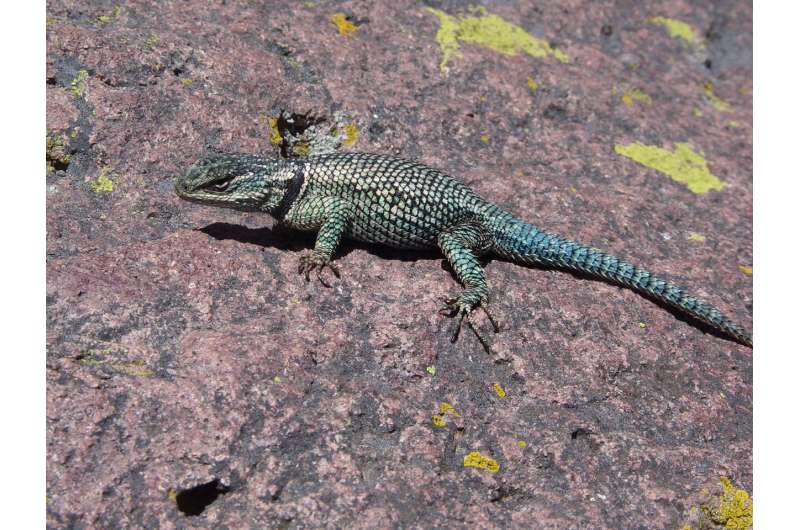This article has been reviewed according to Science X's editorial process and policies. Editors have highlighted the following attributes while ensuring the content's credibility:
fact-checked
peer-reviewed publication
trusted source
proofread
The pace of climate-driven extinction is accelerating, new study shows

Climate change is causing extinctions at an increasing rate, a new study by the University of Arizona researchers shows. They surveyed populations of the Yarrow's spiny lizard in 18 mountain ranges in southeastern Arizona and analyzed the rate of climate-related extinction over time.
The study is published in the journal Ecology Letters.
"The magnitude of extinction we found over the past seven years was similar to that seen in other studies that spanned almost 70 years," said John J. Wiens, a professor in the Department of Ecology and Evolutionary Biology at UArizona, and the senior author of the study.
The Yarrow's spiny lizard native to the southwestern U.S. and western Mexico can be spotted in oak and pine forests in 18 of Arizona's Sky Islands mountain ranges. Wiens and his group did initial surveys of the Yarrow's spiny lizard in these mountain ranges in 2014 and 2015. In 2021 and 2022, Wiens, along with Kim Holzmann, his former master's student and the lead author of the study, and Ramona Walls, a part-time researcher at UArizona's BIO5 institute, resurveyed to investigate if there had been any changes in the lizard populations since then.
During the resurveys, Wiens' group found that about half of the lizard populations at lower elevations had disappeared. This is because temperatures are warmer at lower elevations, Wiens said, and the lizards at lower elevations were presumably not able to tolerate the increasing heat. This loss of low-elevation populations is a signature pattern of climate change, he said.
"The rate of extinction in such a short time period was shocking," Wiens said.
After comparing these findings to historical records from the same mountain ranges, Wiens's group found that the average extinction rate of the lizard populations at low elevations had tripled over the past seven years, relative to the preceding 42 years.
Although previous studies have predicted that climate-related extinctions will increase with the rising pace of global warming, Wiens said he hasn't seen any showing that this acceleration of extinction has already happened.
Also, a distinct 3-million-year-old lineage of the Yarrow's spiny lizard from the Mule Mountains, near Bisbee, may be completely extinct by 2025, according to Wiens.
"The low-elevation populations in the Mules were fine in 2014. Now the only ones that we have found left were within about 300 feet of the top of the mountain in 2022, and they appear to have been losing about 170 feet per year," he said.
However, not all low-elevation populations went extinct between the surveys, Wiens said. For example, two populations that occurred at very low elevations survived. Before they disappeared, the research group had collected genomic data from most of those populations in 2014 and 2015. They found that those populations that were less genetically variable and were exposed to greater climate change effects were the ones that tended to go extinct. This suggests that the populations with less genetic variation had less ability to adapt to climate change.
In the future, Wiens's research group is planning to further study the extinction and survival mechanisms of the Yarrow's spiny lizards living in these mountain ranges. They are also planning to conduct similar studies with other lizard species living in even hotter places, such as California's Death Valley.
Wiens said it is now important to study climate change impacts on biodiversity at shorter timescales instead of only looking for changes after many decades have passed.
"We've shown now that there can be devastating climate change effects over very short time periods," he said.
More information: Kim L. Holzmann et al, Accelerating local extinction associated with very recent climate change, Ecology Letters (2023). DOI: 10.1111/ele.14303
Journal information: Ecology Letters
Provided by University of Arizona




















